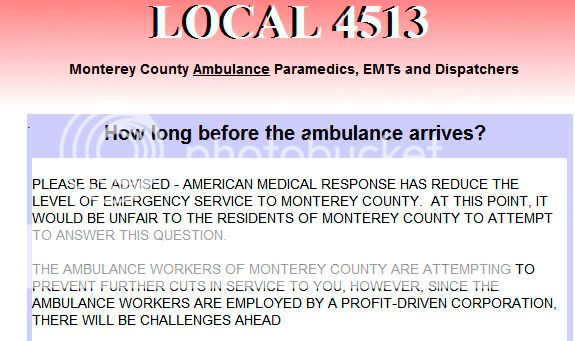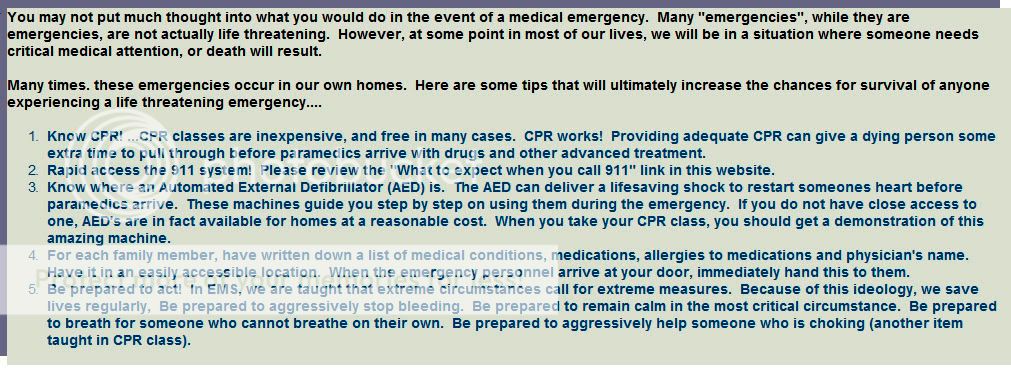Anybody work for these guys? I work in Alameda county and if anybody was keeping up with the events unraveling in this county, they may be moving in as the new 911 provider. If they do, AMR will give us the option of being absorbed by P+. Thanks. Also I couldn't find anything under the search function.
Navigation
Install the app
How to install the app on iOS
Follow along with the video below to see how to install our site as a web app on your home screen.
Note: This feature may not be available in some browsers.
More options
Style variation
You are using an out of date browser. It may not display this or other websites correctly.
You should upgrade or use an alternative browser.
You should upgrade or use an alternative browser.
Paramedic Plus?
- Thread starter smacphee
- Start date
Shishkabob
Forum Chief
- 8,264
- 32
- 48
Paramedic Plus is owned by East Texas Medical Center, or ETMC, which is pretty much the sole 911 provider to most counties east of Dallas. I hear nothing but good about them... aside from their atrocious uniforms.
Paramedic Plus also runs Sunstar out in Florida... haven't heard good things about them though....
Paramedic Plus also runs Sunstar out in Florida... haven't heard good things about them though....
piranah
Forum Captain
- 403
- 6
- 0
sunstar is a great company...two of my co-workers worked there and they loved is
Thanks for the replies. I am wondering if they are a company that could be trusted. Basically I ask because they under bidder am, essentially saying they can run faster response times with less units and money than AMR is currently doing. BTW this is all public information from the county now invade if anybody is wondering
I've heard alot of good about PP, and supposedly they say they can same alco close to 25million? so we'll have to see how that goes. I just hope it's not a flop like when Westmed took over Monterey county, Westmed failed miserably, and AMR had to be brought back in to the county as it's sole 911 provider. Currently AMR monterey has a few lawsuits filed against them for employee pay, along with a slew of other things.
I'm currently applying with AMR Alco,(wish me luck) and next year, PP will take over the contract, because it has already been awarded to them by the county.
I'm currently applying with AMR Alco,(wish me luck) and next year, PP will take over the contract, because it has already been awarded to them by the county.
True, they have only been ok'd for the coming negotiations. The union members here for monterey were given jobs with westmed, then switched back to amr. I've heard that some just switched companies, and I've also heard from others that they had to go through an entire hiring process again to get a job with the new company. Some were re-hired and some here let go... It depends on your county. Do you currently work for amr Alco?
Yeah, I work in alco. The problem for me, as well as a few other people is this. If we decide to go with pp and pp bails like monterey, we will get hired back but with same pay and seniority? Or we choose to transfer with all seniority and are almost garunteed a pay cut. Alco is one of the best paid amr counties.
TransportJockey
Forum Chief
- 8,623
- 1,676
- 113
In my experience, any private EMS company is usually worth avoiding.
And your solution would then be what? Become FFs? I for one have no desire to roll hose for a living.
Shishkabob
Forum Chief
- 8,264
- 32
- 48
In my experience, any private EMS company is usually worth avoiding.
And why is that?
Switching companies is a very touchy thing to do. Here when AMR was first here they paid their employee's very well. Then Westmed came and kept most of the same employee's. I think most if not all were allowed to keep all of their current positions and pay. When Westmed failed, and AMR was allowed back to resurrect the county, AMR was the one that cut everyone's pay, moved everyone's positions around, and even recently fired 11 employee's.
If your in really good standing with AMR, and really do like the company, maybe try switching to AMR operations in a different county? A county that at least has a good rapport.
When is PP scheduled to take over operations? Is amr Alco still hiring?
If your in really good standing with AMR, and really do like the company, maybe try switching to AMR operations in a different county? A county that at least has a good rapport.
When is PP scheduled to take over operations? Is amr Alco still hiring?
Here is a link to what is currently the issue with Monterey County AMR, they are currently warning AMR Santa Clara, because they suspect they could possibly do the same.
www.montereycountyambulance.com
www.montereycountyambulance.com
MusicMedic
Forum Captain
- 499
- 0
- 0
Here is a link to what is currently the issue with Monterey County AMR, they are currently warning AMR Santa Clara, because they suspect they could possibly do the same.
www.montereycountyambulance.com
Wow what a mess!!
i hope PP dosnt end up like westmed, when they underbid and went bankrupt
Seems like Private ambulance companies have idiots running their Accounting/Billing departments
In my experience, any private EMS company is usually worth avoiding.
Switching companies is a very touchy thing to do. Here when AMR was first here they paid their employee's very well. Then Westmed came and kept most of the same employee's. I think most if not all were allowed to keep all of their current positions and pay. When Westmed failed, and AMR was allowed back to resurrect the county, AMR was the one that cut everyone's pay, moved everyone's positions around, and even recently fired 11 employee's.
If your in really good standing with AMR, and really do like the company, maybe try switching to AMR operations in a different county? A county that at least has a good rapport.
When is PP scheduled to take over operations? Is amr Alco still hiring?
Assuming everything goes according to pp's plan, they will start in about a year from now. Amr is still hiring now too. I really like this county for the pay. Compared to other places, AMR Alco pays really well. AMR is fighting really really hard to keep the concract and is picking apart the bid pp put in, obviously.
Shishkabob
Forum Chief
- 8,264
- 32
- 48
Here is a link to what is currently the issue with Monterey County AMR, they are currently warning AMR Santa Clara, because they suspect they could possibly do the same.
www.montereycountyambulance.com
"AMERICAN MEDICAL RESPONSE"
HURTING YOUR COMMUNITY AND
DEGRADING YOUR EMERGENCY
WORKERS.
That, and it's IAFF. IAFF has done just as much, if not more, to hurt EMS than any private provider.
Those two combined made me instantly click out of the website. Don't care to read any fake crap put up to persuade people to on side without any real facts.
JPINFV
Gadfly
- 12,681
- 197
- 63
You know... at a minumum people need to have webpages like that proof read.
Hal9000
Forum Captain
- 405
- 3
- 18
What a mess that site is. The grammar and spelling—vacillating often—are interesting themselves, but the overall communicative style is what I find to be most bizarre. Take these examples:


The thoughts don't look to have been organized/articulated prior to posting, much less proofread. Oh well, it has nice colors, I guess.
The ambulance can be a daunting place for anyone. It is confined, has a lot of equipment throughout, and can make for a bumpy ride.
The paramedic treating you will attempt to make you feel as comfortable as possible. There is heat and air conditioning for your environment, and you are encouraged to let your paramedic know which you prefer.
Much of the treatment in the ambulance is the same that may occur inside the emergency room. As a matter of fact, the same drugs and treatment modalities used by an emergency room physician in a cardiac arrest are also the same on the ambulance, as well.
Depending on the severity of your illness or injury, you may get an easy ride to the hospital, or a "lights and sirens" ride. In many cases, the paramedic will initiate IV access (needle.catheter) while in the back of the moving ambulance with you. Years of experience have refined the paramedics skill to
be able to do this. Paramedics are not successful at this all of the time, but they are most of the time.
You may be provided oxygen by little "nose prongs", or by a full face mask. As a matter of fact, the three most common treatments on an ambulance are : Cardiac Monitor, Oxygen, IV.
Enroute to the hospital, the paramedic will call the emergency room by phone or radio and give them a brief report on the patient's condition so that the emergency room can prepare a bed for them.


The thoughts don't look to have been organized/articulated prior to posting, much less proofread. Oh well, it has nice colors, I guess.
JPINFV
Gadfly
- 12,681
- 197
- 63
I scanned over that last page, but I missed this one. Really? AEDs are sold for a resonable cost? I can't think of the last time I spent $1000 on any one single purchase.
